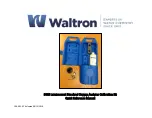
20
1.
A sample of a given substance must be representative. Drawing and preparing a sample is a very
important process as it may affect the repeatability of measurements. The most common method of
homogenizing a sample is mixing. Another method is to draw a few samples from different but
specific points in a substance and calculate an average value, or to draw a few samples from
different points in a substance, mix them, and draw a sample from the mixture.
Note
: The sampling method depends on the type of research being performed. In quality control,
usually many representative samples are analyzed. In production control, it is enough to confirm
sampling repeatability.
2.
When preparing a sample, it is important the sample does not absorb moisture from the surrounding
environment – thus preparation time should be as short as possible.
Note
: If it is necessary to analyze more than one sample at the same time, the samples should be
placed in separate hermetically sealed plastic bags or containers. Make sure the sample does not lose
moisture while it is inside the container (the container or plastic bag should not have much air in it).
3.
Tools and instruments used in the preparation process may affect measurement accuracy. Do not
use tools that transmit heat as this can cause the sample to lose moisture before the actual analysis.
Use only special grinders and mixing instruments. When drawing a sample from a liquid consisting
of solid materials, use a glass mixer, spoon, or magnetic mixer.
4.
To analyze moisture content, place the sample on the disposable pan provided with the unit and
place it in the dryer chamber. Using disposable pans helps to avoid the false results that may be
caused by the residue left from previous samples.
5.
A sample should be always thin and distributed uniformly throughout the pan so that the heat
penetrates equally all over the sample and dries the entire sample effectively.
`
Chapter 10: Preparing the Sample
Correct
Incorrect
Incorrect
















































